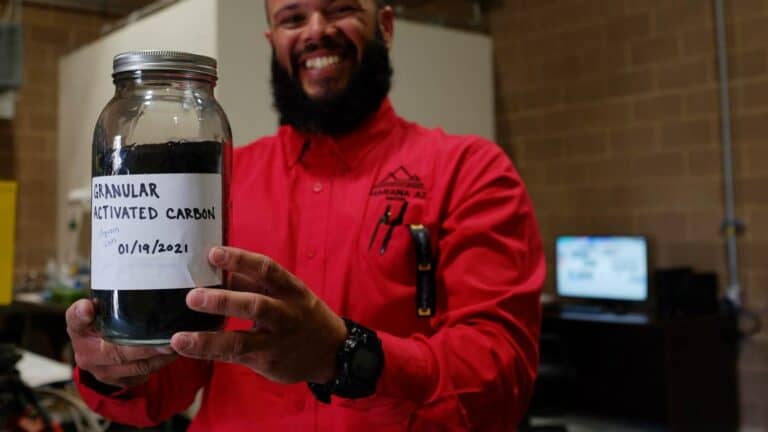Alisa Reznick/KJZZ — Kaulana Breitenbach, water quality specialist for the Marana Water Department, shows a sample of the activated charcoal used to filter out PFAS particles from the water. The treatment plant began using the carbon system in 2021.
PFAS are a group of widely-used, human-made chemicals linked to health issues like cancer and thyroid disease. The Environmental Protection Agency is expected to release a long-awaited set of drinking water standards for the chemicals this year. But contamination has already been found in thousands of communities around the country like Tucson.
The chemicals are found in a range of consumer and industrial products — including a special firefighting foam called AFFF used at airports and military sites like Davis-Monthan Air Force Base in the city’s southside.
“Marana is more than 30 miles away from the military sites clustered in Tucson’s southside. But, PFAS still show up in the water here.”

Photo: Tucson Water Director John Kmiec looks out at a human-made basin full of Colorado River water in the Avra Valley. The basin is one of several the city uses to store river water and allow it to seep into the ground to recharge the aquifer.
Groundwater here is thought to have been contaminated when that foam mixed with affluent and stormwater and seeped into the ground. Tucson Water Director John Kmeic says chemicals spread out from here.
“So groundwater slowly travels, but it still travels from central Tucson to the northwest towards Marana,” he said. “You see impacted groundwater at those two facilities — Davis Monthan, as well as the Morris Air National Guard Base — but then you see groundwater underneath, where the washes and streams, then the Santa Cruz River, going north all the way through the town of Marana.”
Marana is more than 30 miles away from the military sites clustered in Tucson’s southside. But, PFAS still show up in the water here.
“You’re looking at our PFAS treatment plant and 1,4 dioxane. UVA-LP inside there, and then we have our activated carbon in these vessels here,” said Paul Martinez, water operations manager at the Marana Water Department.
He’s pointing out these huge cylinders filled with activated carbon. Groundwater is pumped into one part of the facility and treated for contaminants like 1,4 dioxane using a giant UV light. Those carbon-filled cylinders are where remaining PFAS are absorbed.
It’s a smaller version of the process underway at another treatment facility closer to the military sites in Tucson — where the highest concentrations of PFAS have been found. Today, Kmiec says no residents are drinking water with detectable PFAS levels.
“So where Tucson Water and Marana Water sit is, a lot of people around the country are going to be jealous of […]
Full article: fronterasdesk.org

